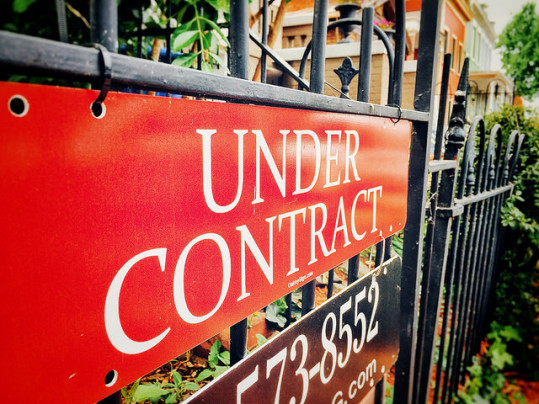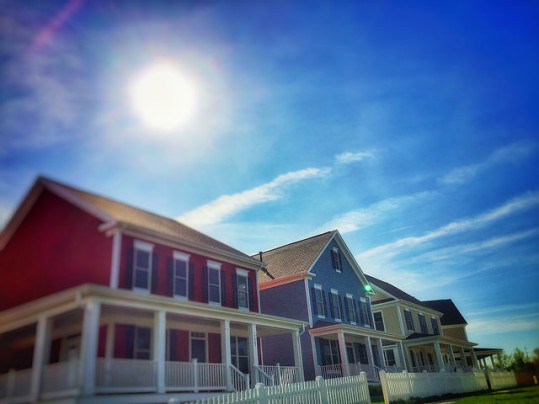For the second straight month, pending home sales increased from the month before, according to new numbers released by the National Association of Realtors. The Pending Home Sales Index – which measures contract signings not closed sales – was up 1.4 percent from the previous month and reached its highest reading in almost a year. Lawrence Yun, NAR’s chief economist, says March’s increase is a sign that the spring buying season is off to a solid start. “Despite supply deficiencies in plenty of areas, contract activity was fairly strong in a majority of markets in March,” Yun said. “This spring’s surprisingly low mortgage rates are easing some of the affordability pressures potential buyers are experiencing and are taking away some of the sting from home prices that are still rising too fast above wage growth.” Though affordability concerns persist, there is still strong demand from buyers – which is being sustained both by low borrowing costs and an improved job market. Regionally, only the West saw a decline in March, falling 1.8 percent from the month before. The Northeast and South were both up approximately 3 percent, while the Midwest was mostly flat. More here.
Archive for April 2016
Demand For Home Loans Up From One Year Ago
The Mortgage Bankers Association’s Weekly Applications Survey looks at the number of Americans who have requested applications for refinance or purchase loans during the past week. It is a good indication of the level of demand for home loans across the country and can also be a predictor of future home sales. According to the most recent results, overall demand for home loans fell last week due, in part, to a drop in refinance activity. Average mortgage rates rose slightly across all loan categories and – because refinance demand tends to be more sensitive to rate fluctuations – activity slipped 5 percent from one week earlier. Refinance volume, however, remains 12 percent higher than one year ago and mortgage rates are still historically low. Purchase application demand dipped last week as well but it is also up from last year’s level. Lynn Fisher, MBA’s vice president of research and economics, told CNBC recent news may not be a fair indication of what’s happening in housing these days. “News about new home sales and single family housing starts fell short of expectations in the last week, however some of March’s housing activity was likely pulled forward into one of the warmest Februarys on record,” Fisher said. “While purchase applications fell slightly last week, the average level for April is the highest since 2010.” The MBA’s weekly survey has been conducted since 1990 and covers 75 percent of all retail residential mortgage applications. More here.
New Home Sales On Pace To Surpass Last Year
New numbers released by the U.S. Census Bureau and the Department of Housing and Urban Development show sales of new homes down 1.5 percent in March from February’s estimate. However, the monthly total doesn’t tell the whole story. A closer look at the report reveals that combined sales for December, January, and February were revised upward by 23,000. Along with the fact that new home sales are still 5.4 percent above last year’s level, that means sales are still on pace to beat last year’s total – which was the best year of sales since 2007. In fact, so far this year, new home sales are already 1.3 percent above the same period last year. Also, economists expect that – though the first quarter of this year has been slower than anticipated – things should pick up as the year goes on. In addition to the relatively good sales news, the median price of a new house was down slightly last month. The report found the median sales price of new homes sold in March was $288,000; the average price was $356,200. More here.
Outlook Unchanged Despite Slow Growth
Despite the fact that economic growth stalled during the first quarter of the year, the outlook for the remainder of the year has not changed, according to Fannie Mae’s Economic & Strategic Research Group’s April 2016 Economic and Housing Outlook. In fact, the group’s latest forecast calls for a pickup in consumer spending and overall growth during the second quarter. Doug Duncan, Fannie Mae’s chief economist, says the housing market should also remain steady, despite some challenges. “Our forecast for housing activity, mortgage rates, and mortgage originations are little changed in the April forecast,” Duncan said. “We expect total mortgage originations to decline about 9 percent in 2016 to $1.56 trillion, with a refinance share of 40 percent. Sustained improvement in the labor market and personal incomes among young adults should draw more potential home buyers into the housing market, but many will continue to face affordability challenges. Home price growth has been rising at a faster clip than incomes, and the increasing supply of single-family housing is skewed toward larger and less affordable homes. These factors continue to weigh on housing affordability, particularly for first-time home buyers.” More here.
Real Estate Remains Top Investment Choice
Americans continue to choose real estate as the “best long-term investment” when given a choice between it and gold, stocks and mutual funds, savings accounts, and bonds. In fact, 35 percent of respondents to a recent poll from Gallup said they thought real estate was the best investment, up from 19 percent in August 2011. Stocks and mutual funds came in second at 22 percent and gold – which topped the list just five years ago – was preferred by only 17 percent of respondents. Gold prices have fallen over the past few years and, as a result, the number of Americans that consider it a good investment has dropped. Real estate, on the other hand, has been rebounding. The average sale price of new homes has risen to $348,900 from $259,300 since 2011 and, with home prices still rising, so has the number of participants who chose it as the safest investment. However, the results vary when broken down into demographic groups. For example, Americans under the age of 30 were the least likely age group to choose real estate and the most likely to prefer savings. On the other hand, stocks were preferred most by Americans with higher incomes. Surprisingly, renters were almost as likely as homeowners to pick real estate as the best investment. More here.
Home Sales Jump To Start Spring
After a disappointing February, sales of previously owned homes bounced back in March, according to new numbers from the National Association of Realtors. In fact, existing-home sales – which include single-family homes, townhomes, condominiums, and co-ops – rose 5.1 percent and were up in all four regions of the country. Lawrence Yun, NAR’s chief economist, says the sales rebound was driven by particularly large increases in the Midwest and Northeast. “Closings came back in force last month as a greater number of buyers – mostly in the Northeast and Midwest – overcame depressed inventory levels and steady price growth to close on a home,” Yun said. “Buyer demand remains sturdy in most areas this spring and the mid-priced market is doing quite well. However, sales are softer both at the very low and very high ends of the market because of supply limitations and affordability pressures.” Supply and affordability have been keeping some buyers at bay, especially first-time home buyers. The report found that new buyers represented just 30 percent of all home sales in March, which is unchanged from last month and also the year before. Typically, first-time home buyers represent closer to 40 percent of sales. More here.
Steady Rates Lead To Increasing Demand
According to the Mortgage Bankers Association’s Weekly Applications Survey, demand for mortgage applications rose last week, though home buying activity was relatively flat from the week before. The Purchase Index – which tracks application demand for loans to buy homes and is considered a good indicator of future sales – was down 1 percent, though it remains 17 percent above last year’s level. The year-over-year improvement suggests buyer interest has been strong so far this spring due, in part, to the fact that mortgage rates remain historically low. Combined with solid job creation, low interest rates are expected to help keep demand high this year by counteracting home price increases and low for-sale inventory. Last week, rates continued to hold firm. In fact, average rates for 30-year fixed-rate mortgages with both jumbo and conforming balances were virtually unchanged from the week before. On the the other hand, mortgage rates for loans backed by the Federal Housing Administration and 15-year loans both decreased. Spurred on by low rates, refinance activity jumped 3 percent, which helped boost overall demand by 1.3 percent. The MBA’s weekly survey has been conducted since 1990 and covers 75 percent of all retail residential mortgage applications. More here.







